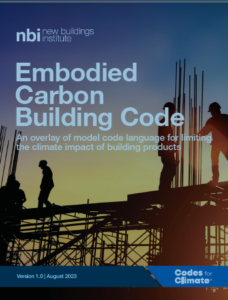The carbon footprint of a building starts at its inception, not when its occupants move in. Products like concrete, steel, aluminum, and insulation are key building components, but until recently were rarely considered by design and construction teams for their impact on climate change. Embodied carbon, which represents the greenhouse gas (GHG) emissions released during the lifecycle of a building (including extraction, manufacturing, transport, construction, and disposal) is now becoming front and center in efforts to decarbonize our built environment.
The building industry is a major contributor of GHG emissions, accounting for 39% of global energy-related carbon emissions worldwide. Of these emissions, one-third comes directly from the creation of construction products and construction activities.
To address embodied carbon in the built environment, some cities and states have already adopted policies requiring building project teams to collect disclosure information about manufacturers’ emissions from making products used in the building’s construction. Disclosing embodied carbon emissions is conducted through environmental product declarations (EPDs), a third-party verified report.

Now, for the first time, embodied carbon emissions are being addressed in national green codes. Following the approval of two new code amendments by the ASHRAE 189.1 Committee, a mandatory low-carbon building product procurement requirement is poised to become part of the International Green Construction Code (IgCC) / ASHRAE 189.1.
The first amendment of the code requires EPD reporting—meaning project teams must select 30 EPDs for a minimum of 20 distinct building products. The combined cost of these products must account for 25% of the total construction product costs. Additionally, building products that cost 5%+ of the estimated material costs must be included. The amendment contains definitions for building products, how to report, and how to calculate the estimated cost of construction products.
A second amendment is a jurisdiction option (JO), allowing adopting jurisdictions to opt into this measure. The amendment requires that complying building products’ global warming potential (GWP) limits be at or below 125% of the industry-wide EPD. The design team can identify which 10 products comply, as long as products cost 5% or more of the building product costs and that, in total, the products equal 15% or 20% of product costs. Details define assembled building products and components.
Addressing embodied carbon within the building industry

The number of cities and states interested in using building codes and policies to require lower carbon product procurement in new construction is growing. NBI has published two groundbreaking resources, Lifecycle GHG Impacts in Building Codes and the Embodied Carbon Building Code overlay, to support jurisdictions as they adopt policies that regulate the most used and highest emitting building products. Today, states and federal agencies (California, Colorado, Oregon, New York, the federal government, including General Services Administration) are adopting procurement policies such as Buy Clean, changing how industries provide and respond to product GWP emissions limits. In August 2023, California became the first state in the country to approve embodied carbon emission control as a mandatory part of the building code (starting in July 2024).
Meanwhile, the Inflation Reduction Act (IRA) directs the U.S. Environmental Protection Agency to develop a standardized way to define and label low-embodied carbon building products and issues millions of dollars to U.S. building product manufacturers to develop EPDs, starting with structural steel, concrete, asphalt, and glass. The IRA also provides $6 billion in grants administered by the U.S. Department of Energy to building product manufacturers that demonstrate significantly less carbon-intensive industrial production processes.
This first-of-its-kind federal legislation ensures EPDs will become the standard method of measuring embodied GHG emissions for building products. It also ensures EPDs will become widely used to measure GWP in the manufacturing and procurement of building products.
Aligning codes with climate action
With the crucial technical support and financial resources in place, the ASHRAE 189.1 Committee took a historic step in September 2023 by approving the two amendments that specifically tackle embodied carbon emissions linked to new construction and substantial renovations.
The ASHRAE 189.1 Committee consists of more than two dozen representatives from major building product groups, experts from government agencies, design professionals, nonprofits, and public interest organizations. The committee spent more than two years developing the amendments under rigorous procedural rules sanctioned by the American National Standards Institute (ANSI) and administered by ASHRAE. This ensured the amendments met a strict standard for public consensus, including multiple rounds of public feedback.
The inclusion of embodied carbon in a national building code represents a significant milestone, reflecting a growing national momentum for aligning codes with the pressing need to address climate change. By mandating building products to measure, report, and enhance their embodied carbon performance, IgCC / ASHRAE 189.1 is aligning with local and state policies regarding embodied carbon. With substantial funding from the IRA to support these efforts, the building industry is poised to make substantial progress in reducing the embodied carbon of building products in the coming years and constructing a greener future for generations to come.
To learn more, please visit NBI’s Codes and Policies resources, where you can find our Embodied Carbon Building Code overlay.
By Jim Edelson, Senior Climate Advisor at New Buildings Institute
Bio
Did you enjoy this content? Consider supporting NBI’s work with a donation today.

